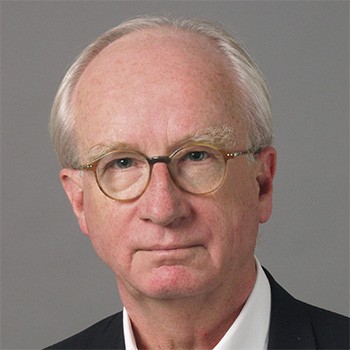
Demis
Hassabis
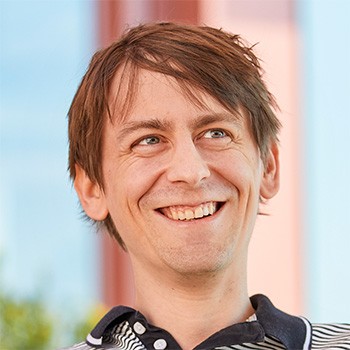
John
Jumper

James
Fujimoto
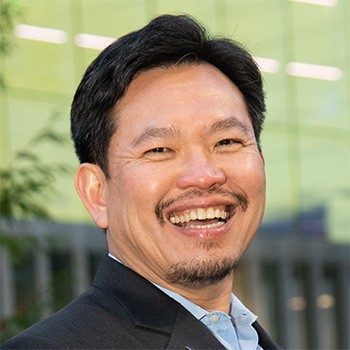
David
Huang
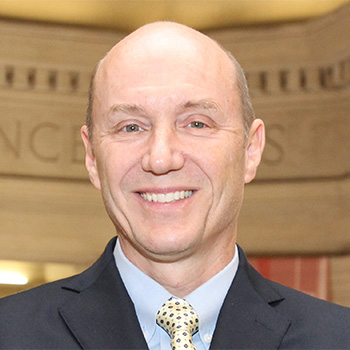
Eric
Swanson
Opening remarks by Joseph L. Goldstein:
The Andy Warhol Supreme Court Case
The Art of Science by Joseph L. Goldstein
The Secret to a Successful Career in Science—According to Magritte
The surreal images of the Belgian artist Rene Magritte, characterized by juxtapositions and visual paradoxes, are widely used by advertisers, filmmakers, cartoonists, and graphic designers. If Magritte’s images have the power to influence the visual vocabulary of the modern media, they may also have the power to influence young scientists by pointing the way to a successful career.
There is no shortage of words of advice on how to become a successful scientist. Among the most celebrated scientists who have written on the subject are the physiologist Claude Bernard (1), the neuroscientist Santiago Ramon Y Cajal (2), the mathematician G. H. Hardy (3), the biochemist Hans Krebs (4), the immunologist Peter Medawar (5), the physicist Richard Feynman (6), and the molecular biologist François Jacob (7). More than tens of thousands of words of advice are contained in the writings of these seven scientists, not to mention the thousands of words of advice written by others.
Magritte’s Lasting Influence on the Popular Culture
During his 45-year career, Magritte (1898-1967) produced more than 1500 paintings that juxtaposed familiar objects in unfamiliar settings. His paintings are among the most admired in the last century. They have had wide influence beyond the confines of the art world, inspiring advertisers, filmmakers, cartoonists, and graphic designers. One of the best examples of Magritte’s influence on the common culture is illustrated by the story of how Paul McCartney got the idea for naming the Beatle’s music company. McCartney deeply admired Magritte’s poetical images of apples, and in 1966 he purchased a Magritte painting of a beautiful big green apple (9). Two years later, Magritte’s green apple (Fig. 1A) became the inspiration for the visual trademark of the Beatles new business venture, which they called Apple Corps. The Apple record company produced many famous Beatles albums like “The White Album,” “Let it Be,” and “Sgt. Pepper’s Lonely Hearts Club Band,” the distinguishing feature of which was the large green apple on the record’s physical imprint (Fig. 1B).
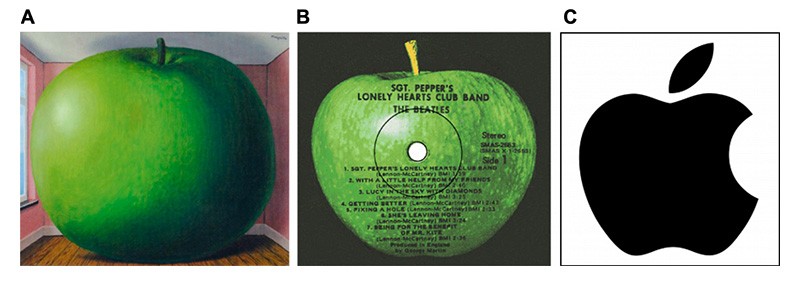
Fig. 1. Influence of Magritte’s Green Apple Painting on Naming of The Beatles’ Apple Records and the Apple Computer. (A) René Magritte. The Listening Room. (1958). Oil on Canvas. 38 x 46 cm. ©2023 C. Herscovici/Artists Rights Society (ARS), New York. (B) Image of Beatles’ Apple Records logo. (1968). (C) Image of Apple Computer logo (1977).
When looking for a name for his computer company in 1976, Steve Jobs, who was an avid Beatles fan and listened to many Apple records (10), may have been inspired—in a roundabout way—by Magritte’s paintings of green apples (11). If a Magritte image could so profoundly influence the most successful recording artists and computer designer in history, then his images may also have the power to influence scientists in pointing the way to a successful career (Fig. 1C).
Asking the Right Question
The first experimental scientist to give advice on the secret to scientific success was Claude Bernard 175 years ago. In the 1850s Bernard discovered that the liver made glycogen and that glucose was derived from glycogen and secreted into blood. This was the beginning of physiology and pharmacology (1). Bernard’s discoveries led him to advance the concept of metabolic homeostasis, which forms the basis for many of today’s ideas on cell signaling and how metabolic pathways are disrupted in cancer (Fig. 2A). A striking example of homeostasis is illustrated by Magritte’s depiction of the leaning tower of Pisa supported by a feather.
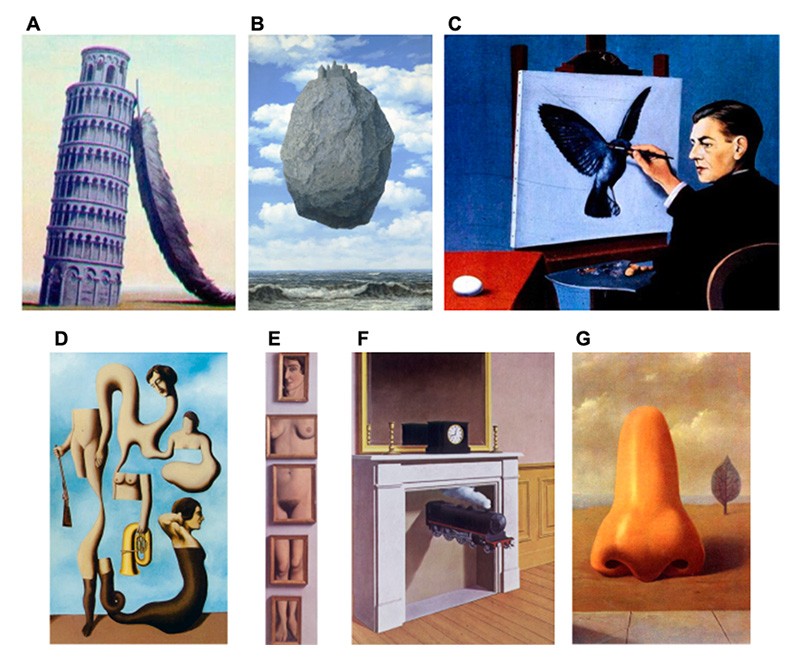
Fig. 2. René Magritte. Oils on canvas. ©2023 C. Herscovici/Artists Rights Society (ARS), New York. (A) Night in Pisa (1958). 97 x 130 cm. (B) The Castle in the Pyrenees (1959). 200 x 130 cm. (C) Clairvoyance (1936). 54 x 65 cm. (D) The Ideas of the Acrobat (1928). 116 x 81 cm. (E) The Eternal Proof (1930). 5 canvases; 22 x 12; 19 x 24; 22 x 19; 22 x 16; 22 x 12 cm. (F) Time Transfixed (1938). 147 x 99 cm. (G) Divine the Future (1937). 65 x 54 cm.
According to Claude Bernard, the key to solving a biological problem is to ask the right question. The answer has already been figured out by Nature. It’s the question that scientists have to discover and define. The importance of asking the right question is illustrated by Michelangelo’s Statue of David. David’s statue was already in the stone; it preexisted but it had to be revealed by Michelangelo. Like Michelangelo, biologists define and solve problems; we don’t invent the answers. Contrary to popular opinion, Watson and Crick did not invent DNA; they revealed its double helical structure. Nature had already invented DNA and knew that it was a double helix. The challenge to a scientist is to ask the right question and then reveal the answer, just like Watson and Crick.
So how does a scientist select the right question to pursue? Magritte’s famous castle painting is an appropriate way to think about the problem (Fig. 2B). For Magritte, an imaginative painting—like the floating rock and castle that never falls to the ground—can evoke a thought that transcends one’s knowledge of the current world. The expression “castles in the sky” is a widely used metaphor for one’s dreams. The more castles one builds in the sky, the more ideas will emerge.
Of the many whimsical castles and ideas that come to mind, how does one go about selecting the best idea and connecting it to the real thing? The answer is clairvoyance (Fig. 2C). The artist looks at an egg and envisions the eagle that it will become. There is no substitute for curiosity and a sense of wonder, which are fundamental to achieving the clairvoyance needed to select the right question.
The theoretical physicist Richard Feynman (winner of the Nobel Prize in 1965 for the theory of quantum electrodynamics) is famous for his outrageous adventures and provocative pronouncements. Feynman advises scientists to tackle messy problems and avoid the obvious ones that everyone else is working on (6). This allows you to cut through the preconceived notions of the crowd and discover nature’s secrets. Feynman’s messy-problem advice is cleverly allegorized in Magritte’s painting, The Ideas of the Acrobat, in which the artist depicts the chaotic and convoluted contortions that an acrobat undergoes in order to perfect his or her routine (Fig. 2D).
After selecting a problem to pursue, the scientist can again turn to Magritte for guidance. The first step in solving a scientific problem is to dissect it into its many essential components, as illustrated by the Magritte painting in which the body is fractured into five sections that do not fit together (Fig. 2E). The clever scientist imagines the missing components that make up the whole body – like the shoulder and most of the leg.
Choosing the Right Mentor
How does one discover the missing components and arrange them in a logical order? The successful scientist, according to Magritte, charges full steam ahead (Fig. 2F), exploring virtually every variable and combination. This is achieved by assembling a group of talented students and postdoctoral researchers. Choosing the right colleagues requires a nose for selecting talent (Fig. 2G). Not only must one be discerning in selecting his or her students and postdocs, but it is also important to be a nourishing mentor who feathers the nests of budding young talent (Fig. 3A). According to the biochemist Hans Krebs (winner of the 1953 Nobel Prize in Physiology or Medicine), the best mentor is one who is both supportive and at the same time teaches you to be ruthless in self-criticism of your own data (4). You can’t choose your parents, but you can choose your mentors!
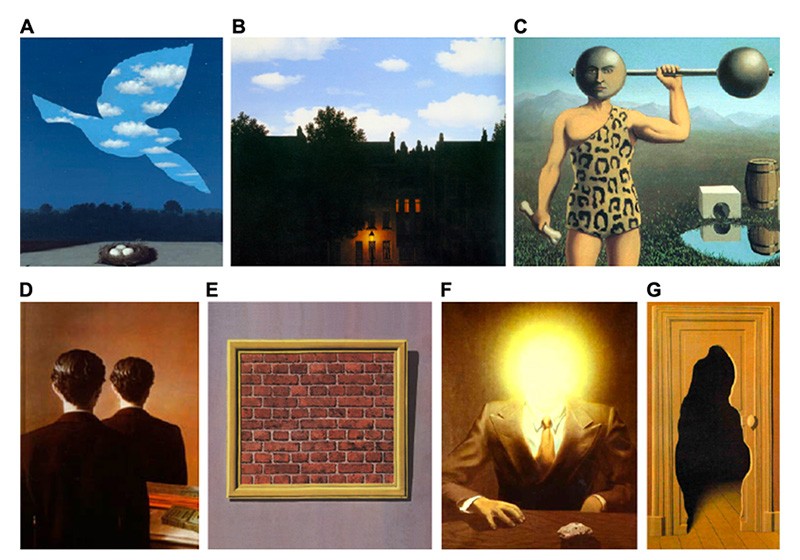
Fig. 3. René Magritte. Oils on canvas. ©2023 C. Herscovici/Artists Rights Society (ARS), New York. (A) Return to the Nest (1940). 100 x 80 cm. (B) The Dominion of Light (1949). 50 x 60 cm. (C) Perpetual Motion (1935). 54 x 73 cm. (D) Not To Be Reproduced (1937). 81 x 65 cm. (E) The Empty Picture Frame (1938). 37 x 43 cm. (F) The Pleasure Principle (1937). 73 x 54 cm. (G) The Unexpected Answer (1933). 81 x 54 cm.
If the lab leader chooses well and mentors well, his younger colleagues will be relentless in their pursuit of solving problems. They will often work day and night where high noon and midnight occur at the same time. In Magritte’s famous painting The Dominion of Light (Fig. 3B), he depicts a sleepy residential street where a street light glows and light shines through the windows. Above this nocturnal landscape is a sunlit sky—a striking impossibility that makes the ordinary extraordinary. This juxtaposition of night and day in the same painting has the power to surprise and delight—just like when a scientist makes an unexpected discovery that opens a new field of science.
In his autobiography The Statue Within, the molecular biologist and winner of the 1965 Nobel Prize in Physiology or Medicine, François Jacob introduced the distinction between “day science” and “night science.” “Day science” is when you do rational experiments building on the shoulders of giants, and “night science” is when new scientific knowledge is elaborated and when future theories and models are tinkered with and conceived (7). There is no better poetic illustration of Jacob’s “day science” and “night science” than Magritte’s The Dominion of Light.
Approaching Your Research With Burning Ambition
According to Peter Medawar, the father of modern immunology and winner of the 1960 Nobel Prize in Physiology or Medicine, to be successful you must have a burning ambition to solve a problem and work hard with fire in the belly (5). Many are familiar with Louis Pasteur’s famous dictum on science, “Chance favors the prepared mind.” In the Medawar sense, it may be more accurate to say “Chance favors the prepared grind.” The harder you work, the luckier you get.
Students and postdocs are motivated to work hard when they see that their lab leader does his or her share of the heavy lifting (Fig. 3C) like maintaining an upbeat morale by guiding them through experimental obstacles, helping with experiments themselves, and providing guidance in obtaining the next job.
The morale in the best of labs is not always rosy, especially when someone’s experiments on Wednesday give different results from the earlier ones on Tuesday – a situation resembling Magritte’s Not to be Reproduced in which we don’t see what we expect to see (Fig. 3D). Here, the man stands facing the mirror with his back to us, but instead of seeing his face in the mirror, we see the back of his head.
Hitting a Brick Wall and Reframing the Problem
Whenever a project in the lab hits a brick wall (Fig. 3E), the successful lab leader needs to take the bull by the horns and exclaim in a loud, but cheerful voice “Now is the time for us to reframe the problem.” Reframing the problem occurs when the brain of the lab leader or someone else in the lab explodes with sparks of intuition that reinvigorate everyone (Fig. 3F). On rare occasions, such a new direction may lead to an experiment that produces an unexpected result that opens the door to new ways of thinking (Fig. 3G). All scientists cherish those rare moments of clarity. Magritte captures that clarity in his painting entitled Clear Ideas (Fig. 4A). Here, you see a rock hovering over the ocean and underneath a cloud. The cloud represents the murky ideas that a scientist wrestles with before he or she experiences one of those light-bulb moments. When the murky ideas crystalize and solidify, the whole being of the scientist, like the rock, is uplifted into the sky, producing that eureka moment and the thrill of discovery.
Many new ideas are not initially viewed favorably by one’s competitors, who try to shoot them down (Fig. 4B). Occasionally a competitor will make a career out of gunning for the creative scientist who advances a new way of thinking about the problem. Scientists who are big thinkers and passionate in their beliefs will persist in proving their new theory by devising clever and convincing experiments that rise above the fray (Fig. 4C).
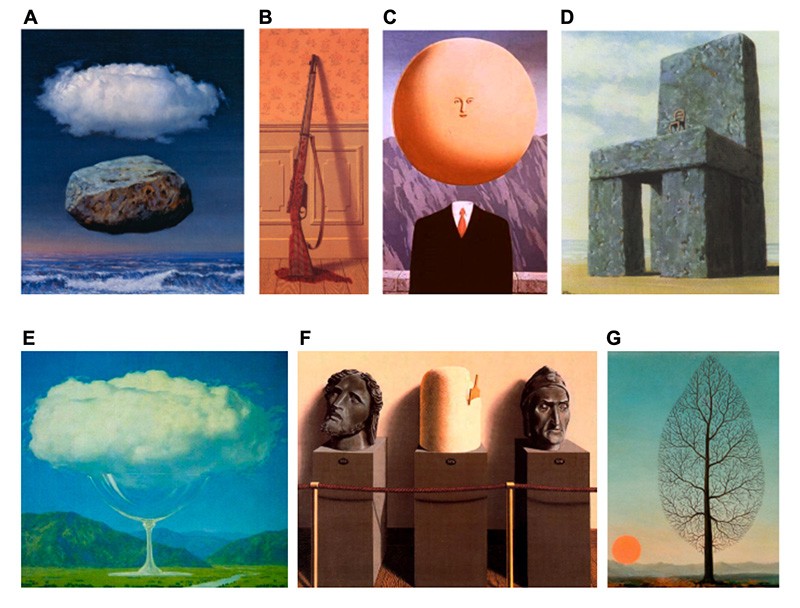
Fig. 4. René Magritte. Oils on canvas. ©2023 C. Herscovici/Artists Rights Society (ARS), New York. (A) Clear Ideas (1958). 50 x 60 cm. (B) The Survivor (1950). 80 x 60 cm. (C) The Art of Living (1967). 65 x 54 cm. (D) The Legend of the Centuries (1950). 55 x 46 cm. (E) The Heartstring (1960). 114 x 146 cm. (F) Eternity (1935). 65 x 81 cm. (G) The Search for the Absolute (1940). 60 x 73 cm.
Celebrating Discoveries That Stand the Test of Time
Scientists who make discoveries that advance biomedical knowledge are often rewarded with an endowed chair (Fig. 4D) that is celebrated by friends and colleagues (Fig. 4E). Endowed chairs and cloud 9-champagne celebrations are nice, but a more important indicator for achieving success in science is depicted in one of Magritte’s most provocative paintings, Eternity (Fig. 4F). Here is a scene from a museum. Behind the velvet rope stand three sculptures: the head of Jesus on the left and the head of Dante on the right. In the middle is a block of butter. Think of the butter as a body of scientific research that can either stand the test of time like the eternal truths of religion and poetry, or melt away if the research is not reproducible.
Experiencing ‘Cerebral Chills’ and ‘Intellectual Kicks’
Of all the pieces of advice on how to become a successful scientist, arguably the most compelling comes from the British scientist G.H. Hardy (1877-1947). Hardy dominated the field of pure mathematics in the early 1900s, known for his achievement in analytic numbers theory. In biomedical circles, he is best known for the Hardy-Weinberg Law, a basic principle of population genetics used to calculate the heterozygote frequency of any genetic trait in the population. Hardy believed that great science is a series of adventures characterized by taste and elegance (3). His idea of a beautiful piece of research is one that combined the qualities of significance, generality, and surprise, producing a “cerebral chill” and an “intellectual kick.”
Magritte’s painting, The Search for the Absolute, is a pictorial rendition of Hardy’s “cerebral chill” and “intellectual kick” (Fig. 4G). Here, Magritte creates the image of a large leaf in the shape of a tree in which the bare branches of the tree-leaf stand in for the veins of the leaf, and the stem of the leaf stands in for the trunk of the tree, which is firmly planted into the ground. Magritte’s choice of title for his tree-leaf, The Search for the Absolute, is an apt reflection of Hardy’s search for “chills” and “kicks.”
The Mystery of Magritte’s Paintings
Magritte’s poetic paintings have had a lasting impact, embedding themselves in the cultural mainstream. His work inspired the leading Pop artists of the 1950’s that included Andy Warhol, Jasper Johns, Jim Dine, and Ed Ruscha. It has also inspired advertising and branding designers who cleverly make use of the bowler hats, floating rocks, giant apples, the CBS eye, and most famously “This is not a pipe”.
But in his wildest dreams, would Magritte ever have imagined that his images could reveal the secret to a successful career in science? The answer to this question may reside in one of Magritte’s comments on the magic of his work. “My paintings are visible images which conceal nothing; they evoke mystery and, indeed, when one sees one of my pictures, one asks oneself this simple question, ‘What does that mean?’ It does not mean anything, because mystery means nothing either, it is unknowable” (12).
2023 Lasker Awards: The Magic of Science’s Secrets
Like the surreal images of Magritte, the research accomplishments of this year’s Lasker awardees are themselves surreal in their revelation of secrets that provide fresh insights that advance the biomedical sciences.
Albert Lasker Basic Medical Research Award
The recipients of this year’s Award are Demis Hassabis and John Jumper (Google DeepMind, London) for their invention of AlphaFold. AlphaFold is the AI system that solved the long-standing challenge of predicting the three-dimensional structure of proteins from the one-dimensional sequence of their amino acids. This transformational method advances our understanding of fundamental biological processes and facilitates drug design.
Lasker~DeBakey Clinical Medical Research Award
The recipients of this year’s Award are James G. Fujimoto (Massachusetts Institute of Technology), David Huang (Oregon Health & Science University), and Eric A. Swanson (Massachusetts Institute of Technology) for their invention of optical coherence tomography (OCT). OCT uses light beams to visualize microscopic structures within tissues of the body, such as the retina. This procedure revolutionized ophthalmology by allowing doctors to detect and treat macular degeneration, glaucoma, and diabetic retinopathy, saving the eyesight of millions.
Lasker~Koshland Special Achievement Award in Medical Science
The recipient of this year’s Award is Piet Borst (Netherlands Cancer Institute) for a 50-year career of scientific discovery and leadership. As a scientist, Borst made seminal discoveries in fields ranging from parasitology to oncology. As a mentor, he inspired and trained scores of Dutch scientists who gained international renown. As a leader, he elevated the Netherlands Cancer Institute to world class status. As a statesman, he promoted European science with vision and diligence.
References
1. C. Bernard, An Introduction to the Study of Experimental Medicine. (New York: Dover Publications). Originally published in French in 1865; first English translation by H. C. Greene in 1927 (1957).
2. Ramon y Cajal (translated by N. Swanson and L. W. Swanson). Advice for a Young Investigator (A Bradford Book). (Cambridge, MA: MIT Press) (2004).
3) G. H. Hardy, A Mathematician’s Apology. (London: Cambridge University Press) (1967).
4. H. A. Krebs, The making of a scientist. Nature 215, 1441-1445 (1967).
5. P. B. Medawar, Advice to a Young Scientist. (New York: Basic Books) (1981).
6. R. P. Feynman, and R. Leighton, Surely You’re Joking, Mr. Feynman! Adventures of a Curious Character. (New York: W. W. Norton & Company) (1997).
7. F. Jacob, The Statue Within: An Autobiography. (Philadelphia: Basic Books, Inc.) (1988).
8. A. Umland, Magritte: The Mystery of the Ordinary, 1926-1938. (New York: The Museum of Modern Art) (2013).
9. S. Kemp, Paul McCartney’s deep adoration for the surrealist artist René Magritte. (2021).
10. W. Isaacson, Steve Jobs. (New York: Simon & Schuster) (2011).
11. C. Silver, How a Magritte painting led to Apple computer (2013).
12. V. Maslov, The pipe and secrets: René Magritte quotes about the imaginary and the real. Artsmarts. January 28, 2019.
Jury
Joseph L. Goldstein, Chair of the Jury, University of Texas Southwestern Medical Center ● Michael Bishop, University of California School of Medicine ● Michael S. Brown, University of Texas Southwestern Medical Center ● Jeffrey M. Friedman, Rockefeller University ● Laurie H. Glimcher, Dana-Farber Cancer Institute ● William G. Kaelin, Jr., Harvard Medical School ● Robert J. Lefkowitz, Duke University School of Medicine ● Richard Lifton, Rockefeller University ● Dan R. Littman, New York University School of Medicine ● Richard M. Locksley, University of California, San Francisco ● Jeremy Nathans, Johns Hopkins University School of Medicine ● Erin O’Shea, Howard Hughes Medical Institute ● Peter Ratcliffe, University of Oxford ● James Rothman, Yale University ● Charles Sawyers, Memorial Sloan-Kettering Cancer Center ● Lucy Shapiro, Stanford University School of Medicine ● Bruce Stillman, Cold Spring Harbor Laboratory ● Marc T. Tessier-Lavigne, Stanford University ● Craig B. Thompson, Memorial Sloan-Kettering Cancer Center ● Harold Varmus, Weill Cornell Medical College ● Leslie B. Vosshall, Howard Hughes Medical Institute ● Xiaowei Zhuang, Harvard University
Jury
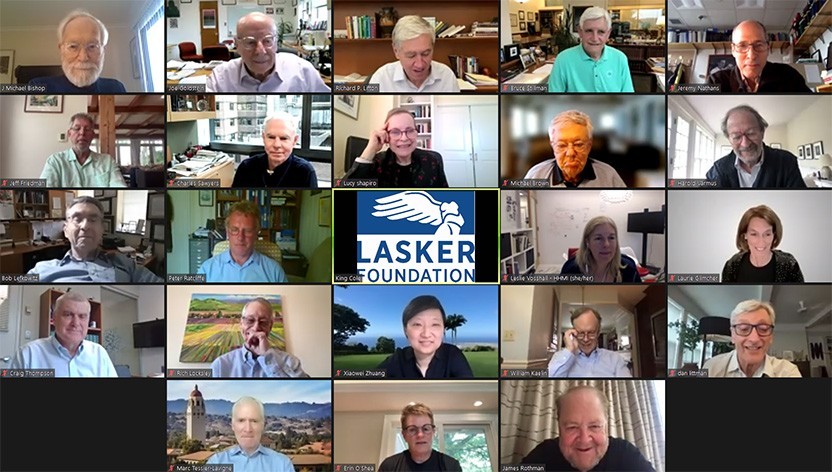
2023 Lasker Medical Research Awards Jury
Top row, left to right
J. Michael Bishop, University of California, San Francisco ● Joseph Goldstein Chair of the Jury, University of Texas Southwestern Medical Center ● Richard Lifton, Rockefeller University ● Bruce Stillman, Cold Spring Harbor Laboratory ● Jeremy Nathans, Johns Hopkins School of Medicine
2nd row
Jeffrey Friedman, Rockefeller University ● Charles Sawyers, Memorial Sloan-Kettering Cancer Center ● Lucy Shapiro, Stanford University ● Michael Brown, University of Texas Southwestern Medical Center ● Harold Varmus, Weill Cornell Medical College
3rd row
Robert Lefkowitz, Duke University School of Medicine ● Peter Ratcliffe, University of Oxford ● Leslie Vosshall, Rockefeller University ● Laurie Glimcher, Dana-Farber Cancer Institute
4th row
Craig Thompson, Memorial Sloan-Kettering Cancer Center ● Richard Locksley, University of California, San Francisco ● Xiaowei Zhuang, Harvard University ● William Kaelin, Dana-Farber Cancer Institute ● Dan Littman, NYU Langone Medical Center
Bottom row
Marc Tessier-Lavigne, Stanford University ● Erin O’Shea, Howard Hughes Medical Institute ● James Rothman, Yale University
Public Service Award Jury

2022 Lasker~Bloomberg Public Service Award Jury
Top row, left to right
Alfred Sommer, Chair of the Jury, Anthony Evnin, Margaret Hamburg, Chris Jones
Bottom row
Sherry Lansing, Elizabeth Nabel, Claire Pomeroy, Elias Zerhouni
